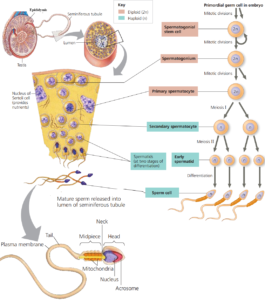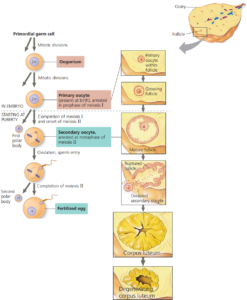Exploring Human Gametogenesis; Production Gametes (Sperm cell and Eggs/Oocytes)

Exploring Human Gametogenesis; Production Gametes (Sperm cell and Eggs/Oocytes)
Content:
- What is gametogenesis?
- Spermatogenesis
- Oogenesis
Gametogenesis
Gametogenesis is the production of gametes (male and female gametes).
In both males and females, there is a close relationship between the gonads’ structure and their function.
There are many parallels between;
- spermatogenesis which is the production of sperm
- and oogenesis the production of oocytes (eggs).
Both processes generate haploid gametes through meiotic divisions of a set of dedicated diploid cells.
In addition, support cells in the gonad play an essential role in both spermatogenesis and oogenesis.
However, there are also several significant differences in gametogenesis between human males and females:
- Spermatogenesis is continuous in adult males. In producing hundreds of millions of sperm each day, cell division and maturation occur throughout the seminiferous tubules. For a single sperm, the process takes about seven weeks. In contrast, oogenesis is a prolonged process in the human female. Immature eggs form in the ovary of the female embryo but do not complete their development until years, and often decades, later.
- In spermatogenesis, the four products of meiosis develop into mature gametes. In oogenesis, cytokinesis during meiosis is unequal, with almost all the cytoplasm segregated to a single daughter cell. This large cell is destined to become the egg; the other products of meiosis, smaller cells known as polar bodies, degenerate.
- Spermatogenesis occurs throughout adolescence and adulthood. In contrast, the mitotic divisions that occur in oogenesis in human females are thought to be complete before birth, and the production of mature gametes ceases at about age 50.
- Spermatogenesis produces mature sperm from precursor cells in a continuous sequence, whereas oogenesis has long interruptions.
Spermatogenesis
Stem cells that give rise to sperm are situated near the outer edge of the seminiferous tubules.
Their progeny moves inward as they pass through the spermatocyte and spermatid stages, and sperm are released into the tubule’s lumen (fluid-filled cavity).
The sperm travel along the tubule into the epididymis, where they become motile.
The stem cells arise from the division and differentiation of primordial germ cells.
In mature testes, the stem cells divide mitotically to form spermatogonia, which in turn generate spermatocytes by mitosis.
Each spermatocyte gives rise to four spermatids through meiosis, reducing the chromosome number from diploid (2n = 46 in humans) to haploid (n = 23).
Spermatids undergo extensive changes as they differentiate into sperm.

The structure of a sperm cell fits its function.
In humans, as in most species, a head containing the haploid nucleus is tipped with a specialized vesicle, the acrosome, which contains enzymes that help the sperm penetrate an egg.
Behind the head, many mitochondria (or one large mitochondrion in some species) provide ATP for movement of the flagellar tail.
Oogenesis
Oogenesis begins in the female embryo with the production of oogonia from primordial germ cells.
The oogonia divide by mitosis to form cells that begin meiosis, but stop the process at prophase I before birth.
These developmentally arrested cells, which are primary oocytes, each reside within a small follicle, a cavity lined with protective cells.
At birth, the ovaries together contain about 1–2 million primary oocytes, of which about 500 fully mature between puberty and menopause.

Beginning at puberty;
Follicle-stimulating hormone (FSH) periodically stimulates several follicles to resume growth and development.
Typically, only one follicle fully matures each month, with its primary oocyte completing meiosis I.
The second meiotic division begins but stops at metaphase.
Thus, arrested in meiosis II, the secondary oocyte is released at ovulation, when its follicle breaks open.
Only if a sperm penetrates the oocyte does meiosis II resume.
(In some other animal species, the sperm enters the oocyte earlier or later.)
Each of the two meiotic divisions involves unequal cytokinesis, with the smaller cells becoming polar bodies that eventually degenerate (the first polar body may or may not divide again).
As a result, the functional product of complete oogenesis is a single mature egg containing a sperm head.
Fertilization is defined strictly as the fusion of the haploid nuclei of the sperm and secondary oocyte, although the term is often used loosely to mean the entry of the sperm head into the egg.
The ruptured follicle left behind after ovulation develops into the corpus luteum.
The corpus luteum secretes oestradiol as well as progesterone, a hormone that helps maintain the uterine lining during pregnancy.
If the egg is not fertilized, the corpus luteum degenerates and a new follicle matures during the next cycle.







providing a deep and well-rounded analysis. Your ability to delve deeply into the topic while maintaining clarity and coherence is commendable.